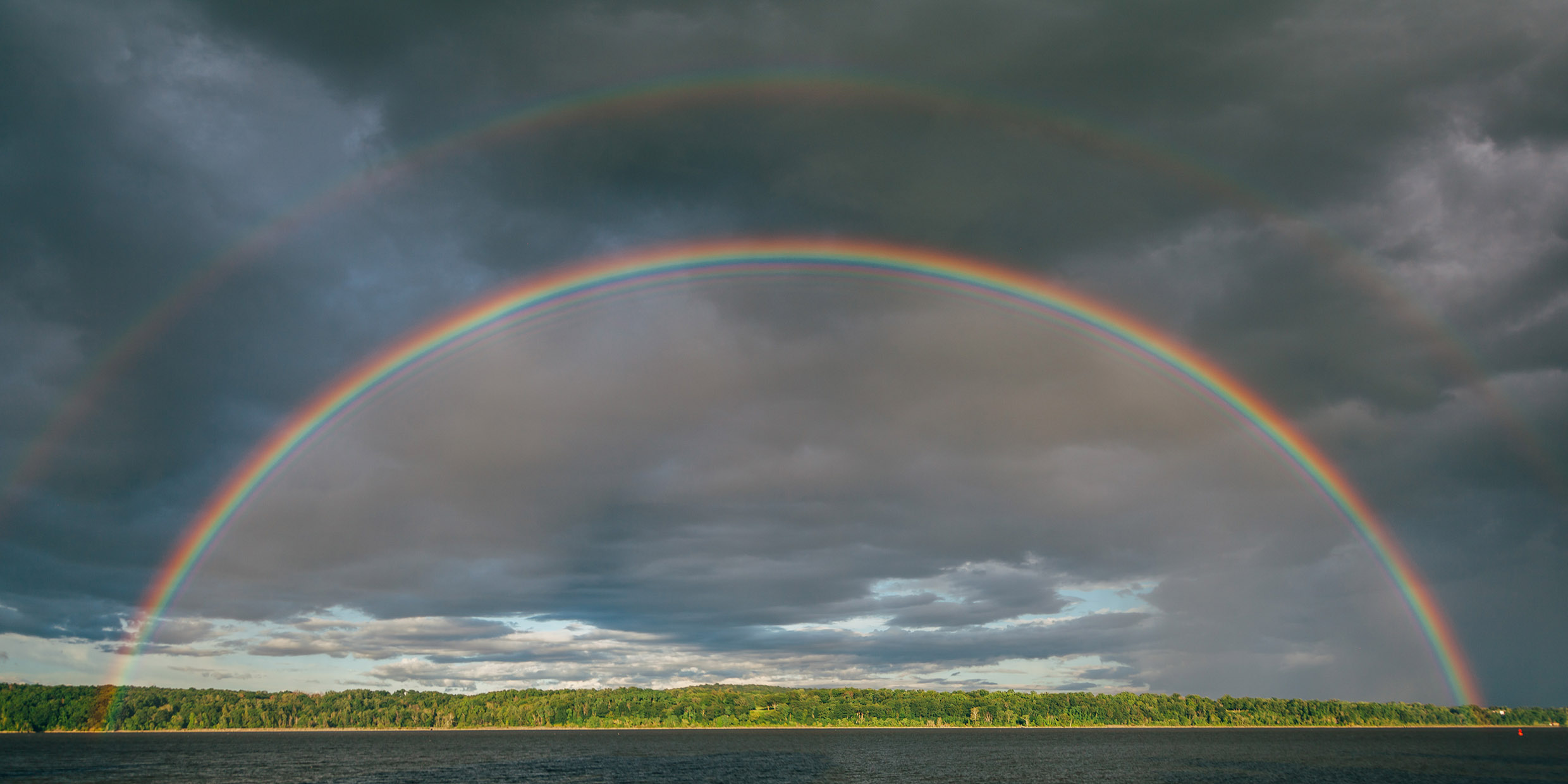Originally published 9 January 1989
With snowflakes in the air, this may seem to be the wrong time of the year to be writing about rainbows. But I’ve just read for the second time Fred Schaaf’s essay “100 Rainbows” in his new book The Starry Room, and I’m reminded that rainbows are not necessarily a seasonal phenomena.
For five years Schaaf wrote the “Eye on the Sky” column for Astronomy magazine, and he continues to be the astronomy essayist for The Old Farmer’s Almanac. He is a gifted observer of things in the sky — meteors, comets, planets, stars, and other celestial lights.
Among other things, Schaaf is a rainbowologist, if such a thing exists. He is a collector of rainbows, and he knows you don’t need a summer rain to see a rainbow in the sky. Among the 100 different kinds of rainbows he lists in his essay are the “rainbow cut off by falling snow” and “rainbow over a snowy landscape.”
Snowflakes cannot produce a rainbow, only drops of water can do that. But it is not impossible to have snowflakes and drops of water in the same field of view at the same time. Even in summertime snow sometimes occurs high up in rain clouds, and the flakes can terminate the arc of a rainbow. Schaaf reports seeing such a thing. And of course a waterfall can make a spray of bow-producing mist in a landscape of snow. I saw a bow this bright winter morning while misting the houseplants.
Learning the signs
The kind of rainbow most of us have seen is called a primary bow. It is visible when the sun is shining at your back, low in the sky, and there is rain in front of you. I have occasionally surprised friends by successfully foretelling the precise moment and location of a beautiful bow, but if one has seen enough rainbows it is easy to predict when the right conditions are about to occur. Schaaf says he sometimes calls people on the telephone to tell them a rainbow is heading their way.
There are lots of variations on the primary bow, and Schaaf lists them all. The not-uncommon secondary rainbow is usually fainter and outside of the primary bow, with the order of colors reversed. Secondary bows are caused by a second reflection of sunlight within the raindrop before it emerges. A third reflection in the raindrop produces a tertiary rainbow, but these are rare and seldom seen.
Schaaf lists the most distant natural rainbow he has heard about (80 miles) and the nearest (three yards). He gives separate entries in his list to rainbows seen at sunrise or sunset, a rainbow with lightning striking through it, a rainbow shaken by thunder, and a rainbow seen in conjunction with the moon. In fact, Schaaf lists so many beautiful possibilities that the proverbial pot of gold at the rainbow’s end begins to seem a less desirable reward than the rainbow itself.
Some places are better for rainbow watchers than others, and New England is not the best, even in summer. Those of you who are going south for a winter vacation will be less upset by rain if you look for the generously provided tropic bows. Schaaf says there are places in the Hawaiian Islands where rain is unceasing and in early winter, when the sun is low in the sky, a rainbow can be watched all day long.
In the eye of the beholder
I spend part of every year in southwest Ireland, a superb place for an amateur rainbowologist. Once I saw four rainbows in a single day, surely not a record but an achievement of which I am proud. With so many rainbows to observe it soon becomes obvious that no two bows are the same. Even the prominence of colors in the spectrum varies from rainbow to rainbow, depending on the size of the water droplets producing the bow.
Strictly speaking, everyone who looks at a rainbow sees a different bow. Rainbows don’t exist out there, like a tree or a star, to be seen alike by every observer. Rainbows exist only on the retina of an eye, and every observer’s eyes have a different posture with respect to rain and sun.
Almost any source of light and any kind of mist can produce a bow of sorts. Schaaf lists rainbows you can see at any season of the year — mistbows, fogbows, cloudbows, dewbows, geyserbows, and bows in the spray of a garden hose or lawn sprinkler. He includes among his 100 rainbows those caused by searchlights, streetlights, lightning, and even volcanic light.
There is more to Schaaf’s book than rainbows. The subtitle of the book is “Naked Eye Astronomy in the Intimate Universe.” The author knows you don’t need a telescope to do astronomy. The sky abounds with phenomena — wonderful lights of all kinds, at all seasons, day and night, available to everyone. Schaaf’s list of 100 rainbows is just a taste of what is there to be seen, and his delightful essays are an irresistible invitation to go look.
Every year around Christmas time I am asked for recommendations by people who want to buy a telescope as a gift for a child or spouse. My advice is usually, “don’t.” Unless one is willing to pay more than a few hundred dollars, the telescope will provide more frustration than pleasure. And unless one is already reasonably familiar with the sky, even an expensive instrument will tend to sit idle in the basement or garage.
That’s the valuable lesson of Schaaf’s book: An amateur astronomer, meteorologist, or rainbowologist needs only a good pair of eyes to get on intimate terms with the universe.



